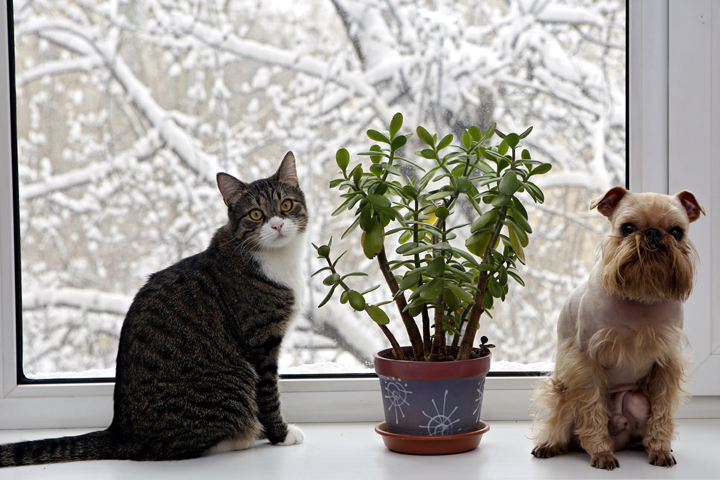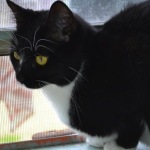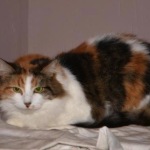
Unleashed: Could your pets be SAD?
Think the humans in your household are the only ones who can suffer winter doldrums? Psychology and veterinary professionals assert some pets also fall prey to Seasonal Affective Disorder (SAD).
In Psychology Today, author and psychologist Stanley Coren cites a British survey that says 40% of dog owners saw a considerable downturn in their pet’s moods during the winter months. Owners also reported their dogs slept longer and were less active overall. One-third of cat owners surveyed also claimed their feline friends seemed “sadder” and less playful during wintertime. A quarter of both dog and cat owners noticed their pets’ appetites increased in the winter.
As in humans, Coren says, these changes result from light’s affect on the production of the hormones melatonin and serotonin. Cued by low light or nighttime conditions, melatonin promotes sleep and a feeling of low energy. Sunlight is needed to produce serotonin, which affects appetite and a feeling of wellbeing. In the winter, both people and pets can have a melatonin excess and serotonin deficiency, which combines to create SAD.
|
|
FETCH! Pet Care CEO Paul Mann says there are a few simple things pet owners can do to physically engage and psychologically stimulate their pets to make everyone happier during the long, cold winter months including:
Encourage exercise. Being outside provides dogs with the sensory stimulation they crave and activates their natural play. Running, jumping and chasing burns calories, boosts metabolism and energizes pets. If owners don’t want to brave the winter weather to walk or play, they may want to hire a professional dog walker—or responsible young neighbor, who may be eager to blow off steam outdoors.
If indoor play is the only option, short-range fetch, laser pointer tag or a low-cal treat or squeaky toy scavenger hunt can serve as a great workout that stimulates a pet’s appetite and can get the whole family moving. A motorized animal treadmill might also be an option.
Since cats love to pounce and bounce, it’s easy to engage them in 10-to-15 minutes of play each day. Balls with bells, laser pointers, teaser toys on a stick and other enticing toys that move horizontally (to mimic their natural prey) entice cats into chase mode. Once they’re revved up, they expend energy in short bursts. A perch by a window invigorates cats as they see an ever-changing landscape and stalk wildlife, leaves or anything else that moves.
Introduce animal-rousing aromas. Scented toys can engage an animal’s interests and stalking instincts and keep them occupied and mentally focused as they try to find the source of the smell. Luckily dogs respond to a variety of smells. An infinite variety of toys are available to engage canine olfaction; some are multi-sensory and include bells and squeakers.
For cats, “play sprays,” in alluring scents such as catnip, can be squirted onto indoor climbing structures, cardboard boxes and scratching posts. A multi-story cat tree with strategically placed low-cal treats or scented play toys can readily get kitties jumping from level to level and their heart pumping.
Count calories. If pets don’t get outdoors as often as usual, they probably don’t need as much food. Reducing food and calorie intake generally means less weight gain and more energy. Hiding treats inside toys (such as freezing kibble inside a Kong) can provide prolonged entertainment and activity without increasing calories.
Let the sunshine in (even artificially). Both pets and their owners can benefit from tying back the drapes and opening blinds to let in as much natural light as possible. Owners can also boost light exposure by using full-spectrum (also known as daylight) light bulbs or even a light box.
With just a little planning, owners can ensure their pet’s winter season remains happy and healthy with a great quality of life for everyone in the household.
If you’re interested in adding a furry member to your household, APAWS has a variety of adoptable animals available including:
Creature Feature
 Teddy is a young Australian shepherd/lab mix puppy. He is a lazy little teddy bear, a dominant trait that inspired his name. Teddy would love a home with a nice yard, so he can run and play.
Teddy is a young Australian shepherd/lab mix puppy. He is a lazy little teddy bear, a dominant trait that inspired his name. Teddy would love a home with a nice yard, so he can run and play.
 Miranda and her siblings were rescued by an APAWS volunteer. This grey-and-white tabby kitten is very sweet and would be an adorable addition to any family.
Miranda and her siblings were rescued by an APAWS volunteer. This grey-and-white tabby kitten is very sweet and would be an adorable addition to any family.
 Rufus is a 4-year-old Maltese/terrier mix. Weighing in at a sturdy 17 pounds, this boy loves to cuddle and snuggle and is more than eager to jump into human friend’s lap. He enjoys playing with other dogs and is curious about cats. But, his prey drive kicks in around chickens, rabbits, etc., so a home without livestock would be best. Rufus has been moved around a lot and deserves a stable loving home with someone who will adore him.
Rufus is a 4-year-old Maltese/terrier mix. Weighing in at a sturdy 17 pounds, this boy loves to cuddle and snuggle and is more than eager to jump into human friend’s lap. He enjoys playing with other dogs and is curious about cats. But, his prey drive kicks in around chickens, rabbits, etc., so a home without livestock would be best. Rufus has been moved around a lot and deserves a stable loving home with someone who will adore him.
 Ariel is a very active cat with a very outgoing personality. She would be a great companion for another cat who likes to roughhouse and needs a play buddy. Ariel is best suited to a home without small children. She needs to find a family who appreciate a high energy, playful cat.
Ariel is a very active cat with a very outgoing personality. She would be a great companion for another cat who likes to roughhouse and needs a play buddy. Ariel is best suited to a home without small children. She needs to find a family who appreciate a high energy, playful cat.
 Morgan is a 6-week-old pup, who looks to be a mastiff/lab mix. She has large paws and will probably be a big dog. A family found her on an Arkansas interstate and brought her to APAWS because they couldn’t keep her. Morgan will remain with an APAWS foster she is spayed and has all her puppy vaccinations; however, the rescue is taking applications for her adoption.
Morgan is a 6-week-old pup, who looks to be a mastiff/lab mix. She has large paws and will probably be a big dog. A family found her on an Arkansas interstate and brought her to APAWS because they couldn’t keep her. Morgan will remain with an APAWS foster she is spayed and has all her puppy vaccinations; however, the rescue is taking applications for her adoption.
 Sophie is a super shy cat. Before the owner became too ill to care for her, this medium-haired calico was a companion to an elderly man and his daughter. Sophie has been very withdrawn ever since she came into rescue. She needs someone with a lot of love and patience to teach her people can be good and will love her.
Sophie is a super shy cat. Before the owner became too ill to care for her, this medium-haired calico was a companion to an elderly man and his daughter. Sophie has been very withdrawn ever since she came into rescue. She needs someone with a lot of love and patience to teach her people can be good and will love her.
These pets have all been microchipped, vaccinated, spayed/neutered, heartworm and FeLeuk/FIV tested. Many other adoptable cats, kittens, puppies and dogs are available at the Animal Protection and Welfare Society.
|
|
|
